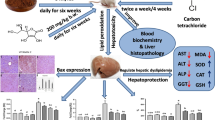Summary
The influence of acrolein on hepatocytes and the effect of a-tocopherol on acrolein cytotoxicity were investigated using primary cultured rat hepatocytes. Hepatocellular injury was dependent on both acrolein concentration in medium and on duration of exposure. Treatment of hepatocytes with 100 μM acrolein resulted in a marked loss of cellular glutathione (GSH) within 15 min, gradual accumulation of cellular lipid peroxide (LPO) and subsequent lactate dehydrogenase (LDH) leakage in the medium from 3 hr after exposure to acrolein. Cellular GSH peroxidase (GSH-Px) activity at 2 hr was significantly decreased. Electron microscopic examination on hepatocytes at 8 hr revealed a marked swelling of mitochondria and ruptures of the plasma membrane. Simultaneous treatment with 100 μM acrolein and 20 μM α-tocopherol did not prevent the loss of cellular GSH, though it prevented the LPO accumulation and the LDH leakage. The decrease of cellular GSH-Px activity with acrolein treatment was not mitigated by cotreatment with a-tocopherol. Ultrastructural alterations of hepatocytes induced by acrolein were minimized by co-treatment with α-tocopherol. In conclusion, acute loss of GSH and GSH-Px may increase cellular LPO and lead to hepatocellular injury, though suppression of cellular LPO accumulation by α-tocopherol can prevent the hepatocellular injury, even under condition of lack of GSH and GSH-Px.
Similar content being viewed by others

References
Izard C, Libermann C: Acrolein. Mutat Res 1978;47:115–138.
Lipari F, Sivarin SJ: Determination of formaldehyde and other aldehydes in automobile exhaust with an improved 2,4-dinitrophenyl-hydrazine method. J Chromatogr 1982;247:297–309.
Rees KR, Tarlow MJ: The hepatotoxic action of allyl formate. Biochem J 1967;104:757–761.
Gurtoo HL, Mainello AJ, Struck RF, et al: Studies on the mechanism of denaturation of cytochrome P-450 by cyclophosphamide and its metabolites. J Biol Chem 1981;256:11691–11701.
Haenen GR, Vermeulen NP, Tai Tin Tsoi JN, et al: Activation of the microsomal glutathione S-transferase and reduction of the glutathione dependent protection against lipid peroxidation by acrolein. Biochem Pharmacol 1988;37:1933–1938.
Miccadei S, Nakae D, Kyle ME, et al: Oxidative cell injury in the killing of cultured hepatocytes by allyl alcohol. Arch Biochem Biophys 1988;265:302–310.
Miccadei S, Kyle ME, Gilfor D, et al: Toxic consequence of the abrupt depletion of glutathione in cultured rat hepatocytes. Arch Biochem Biophys 1988;265:311–320.
Silva JM, O’brien PJ: Allyl alcohol- and acrolein-induced toxicity in isolated rat hepatocytes. Arch Biochem Biophys 1989;275:551–558.
Niki E, Tsuchiya J, Tanimura R, et al: Regeneration of vitamin E from α-chromanoxyl radical by glutathione and vitamin C. Chem Lett. 1982;789-792.
Nakano M, Sugioka K, Nakamura T, et al: Interaction between an organic hydroperoxide and an unsaturated phospholipid and α-tocopherol in model membranes. Biochim biophys Acta 1980;619: 274–286.
Seglen PO: Preparation of isolated rat liver cells. Method Cell Biol 1976;13:29–83.
Odashima S, Sturgess JM, Rothstein A: Studies with mature rat hepatocyte in monolayer culture. Cell Tis Res 1976;169:167–168.
Yagi K: A simple fluorometric assay for lipoperoxide in blood plasma. Biochem Med 1976;15:212–216.
Tietze F: Enzymic method for quantitative determination of nanogram amounts of total and oxidized glutathione: applications to mammalian blood and other tissues. Anal Biochem 1969;27: 502–522.
Lowry O, Rosebrough N, Farr A, et al: Protein measurement with the Folin phenol reagent. J Biol Chem 1951;193:265–275.
Lawrence RA, Burk RF: Glutathione peroxidase activity in selenium-deficient rat liver. Biochem Biophys Res Commun 1976;71:952–958.
Dawson JR, Norbeck K, Anundi I, et al: The effectiveness of N-acetylcysteine in isolated hepatocytes, against the toxicity of paracetamol, acrolein, and paraquat. Arch Toxicol 1984;55:11–15.
Hishinuma I, Nakamura T: αTocopherol and inhibition of cytolysis in glutathione-depleted hepatocytes in primary culture. J Nutr Sci Vitaminol 1988;34:11–23.
Sandy MS, Monte DD, Smith MT: Relationships between intracellular vitamin E, lipid peroxidation, and chemical toxicity in hepatocytes. Toxicol Appl Pharmacol 1988;93:288–297.
Starke PE, Farber JL: Endogenous defenses against the cytotoxicity of hydrogen peroxide in cultured rat hepatocytes. J Biol Chem 1985;260:86–92.
Harman LS, Carver DK, Schreiber J, et al: One- and two-electron oxidation of reduced glutathione by peroxidases. J Biol Chem 1986;261:1642–1648.
Hormann VA, Moore DR, Rikans LE: Relative contributions of protein sulfhydryl loss and lipid peroxidation to ally1 alcohol-induced cytotoxicity in isolated rat hepatocytes. Toxicol Appl Pharmacol 1989;98:375–384.
Mirabelli F, Salis A, Marinoni V, et al: Menadione-induced bleb formation in hepatocytes is associated with the oxidation of thiol groups in actin. Arch Biochem Biophys 1988;264:261–269.
Author information
Authors and Affiliations
Rights and permissions
About this article
Cite this article
Watanabe, M., Sugimoto, M. & Ito, K. The acrolein cytotoxicity and cytoprotective action of α-tocopherol. Gastroenterol Jpn 27, 199–205 (1992). https://doi.org/10.1007/BF02777723
Received:
Accepted:
Issue Date:
DOI: https://doi.org/10.1007/BF02777723



